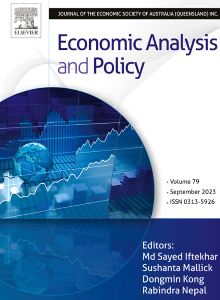产业数字化与城乡收入差距:基于中国30个省份数据的实证分析
IF 8.7
2区 经济学
Q1 ECONOMICS
引用次数: 0
摘要
本文基于2011 - 2022年中国30个省区面板数据,首先运用熵值法构建工业数字化评价指标体系,然后运用多维计量模型系统分析工业数字化对城乡收入差距的影响机制,最后深入探讨工业数字化对城乡收入差距的影响及其深层机制。实证结果表明,工业数字化的发展显著缩小了城乡收入差距,其影响呈现出“中部省区”的区域异质性特征;西部省区;东部省份地区。”创新水平作为关键中介变量,在传导过程中产生掩蔽效应,结果表明,工业数字化提高了创新水平,间接拉大了城乡差距3.1%。产业集聚的调节作用呈现出双重特征,既强化了产业数字化的直接减贫效应,又通过中介途径减弱了创新水平的负面影响。进一步通过空间集聚溢出效应揭示了异质性的产生机制。本研究揭示了数字经济时代城乡协调发展的复杂机制,提出实施差别化区域数字战略,构建基础设施建设、创新成果转化、产业链协同的城乡协调发展立体政策体系,通过优化数字红利分配机制促进共同繁荣。本文章由计算机程序翻译,如有差异,请以英文原文为准。
Industrial digitalization and urban-rural income gap: An empirical analysis based on data from 30 provinces in China
Based on the panel data of 30 provincial regions in China from 2011 to 2022, this paper first constructs an evaluation index system of industrial digitalization by using the entropy method, then systematically analyzes the impact mechanism of industrial digitalization on the urban-rural income gap by applying a multi-dimensional econometric model, and finally deeply explores the influence of industrial digitalization on the urban-rural income gap and its underlying mechanism. The empirical results show that the development of industrial digitalization has significantly narrowed the urban-rural income gap, and its effect presented a regional heterogeneity characteristic of "central province regions> western province regions> eastern province regions." Innovation level, as a key mediating variable, generates a masking effect in the transmission process, and the result shows that industrial digitization has improved innovation level, indirectly widening the urban-rural gap by 3.1%. The moderation effect of industrial agglomeration exhibits dual characteristics, strengthening the direct poverty reduction effect of industrial digitization and weakening the negative impact of innovation level through intermediary pathways. Further analysis reveals the heterogeneity generation mechanism through spatial agglomeration-spillover effects. This research reveals the complex mechanism of urban-rural coordinated development in the era of the digital economy and proposes implementing differentiated regional digital strategies, constructing a three-dimensional policy system for urban-rural coordinated development consisting of infrastructure construction, innovation achievement transformation, and industrial chain collaboration, and promoting common prosperity through optimizing the digital dividend distribution mechanism.
求助全文
通过发布文献求助,成功后即可免费获取论文全文。
去求助
来源期刊

Economic Analysis and Policy
ECONOMICS-
CiteScore
9.80
自引率
9.20%
发文量
231
审稿时长
93 days
期刊介绍:
Economic Analysis and Policy (established 1970) publishes articles from all branches of economics with a particular focus on research, theoretical and applied, which has strong policy relevance. The journal also publishes survey articles and empirical replications on key policy issues. Authors are expected to highlight the main insights in a non-technical introduction and in the conclusion.
 求助内容:
求助内容: 应助结果提醒方式:
应助结果提醒方式:


